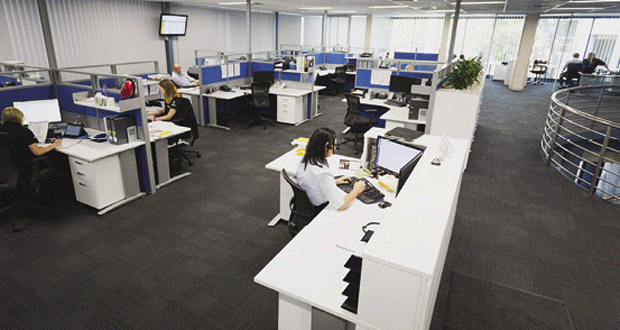 Alan Macklin, Technical Director at Elta Group and Chairman of the Fan Manufacturer’s Association (FMA), on providing safe and adequate ventilation for building occupants
Alan Macklin, Technical Director at Elta Group and Chairman of the Fan Manufacturer’s Association (FMA), on providing safe and adequate ventilation for building occupants
As FMs look at the safest ways of reopening offices, there is a lot of attention on how the health and safety of employees can be managed, with the focus understandably being on minimising the transmission of COVID-19.
Given there is still so much we do not know about the disease, facilities managers face a massive challenge in ensuring sites such as offices are as safe as possible. This has largely meant implementing social distancing measures, but ongoing research into how COVID-19 spreads has highlighted the potentially important role that ventilation will play in helping people to return to the workplace.
RESTARTING SYSTEMS AFTER A PERIOD OF DISUSE
When faced with a building that has been unoccupied for a sustained period of time, a facilities manager’s first task will be to restart ventilation systems that may have been inactive for several months. This requires a thorough and strategic approach, to ensure equipment is working as effectively as it should be.
Regular checks and maintenance should become a matter of routine even after a return to work, with recommendations including to purge ventilate for two hours before and after occupancy and maintain trickle ventilation even when the building is not occupied i.e. overnight. Even putting the concerns associated with COVID-19 to one side, there are links between occupant health and indoor air quality (IAQ) that must be addressed. The concerning re-emergence of Sick Building Syndrome, in which employees suffer from symptoms such as headaches and sore throats, highlights the importance of good IAQ. As workplaces start to reopen, facilities managers must ensure that existing ventilation systems are working as effectively as possible, to mitigate these health concerns.
VENTILATION AND ITS LINK WITH INFECTION TRANSMISSION
As we’ve alluded to already, there is still much we do not know about COVID-19. However, recent research into transmission of the disease has highlighted the role that air circulation could play, and how careful management of indoor air may contribute to a safer working environment.
One of the primary reasons for this is the link between dry air and a number of health problems, including asthma and skin irritation. Most pertinently, dry air can also result in higher rates of infection transmission, which is something that is often seen with seasonal influenza and the common cold.
Our understanding of how COVID-19 spreads suggests that maintaining a level of relative humidity could be a powerful tool in ensuring the health and safety of building occupants. There is currently a general consensus that between 40-60 per cent humidity is optimum for occupant health, and the onus will be on facilities managers to manage air circulation to help achieve this level.
With research ongoing, it is difficult to prescribe an absolute one-size-fits-all solution. However, there is sufficient evidence to suggest that effective ventilation, whether that be a natural or mechanical strategy, reduces infection rates for diseases such as COVID-19.
As workplaces start to reopen, consideration must be given to whether existing systems can cope with the possible increase in demand. With factors such as humidity and thermal comfort also integral to a safe and healthy working environment, facilities managers will have to ensure effective ventilation strategies are in place.
COMMON MISCONCEPTIONS AND CONCERNS
Facilities managers are likely to have a number of questions with regards to ventilation’s role in reopening workplaces, and returning employees will no doubt have concerns of their own. Although the unprecedented nature of COVID-19 means we do not yet know all the answers, there are a few common misconceptions that facilities managers should familiarise themselves with.
Q Is there a risk that ventilation systems will spread pathogens?
A The risk of spreading pathogens can be minimised by avoiding recirculating indoor air. The ventilation system should be configured to provide increased rates of fresh outside air at all times, even when the building is not occupied.
Q How will social distancing measures and reduced occupancy affect ventilation?
A Where measures have been taken to provide protection against transmission, such as screens between employees, attention should be paid to ensure that a flow of fresh air is able to replace any stagnant air that may become trapped by the screens. This is also an important consideration with toilet cubicles, whereby a continuous extract of stale air must be guaranteed, and replaced with fresh air.
Q Can filtration remove COVID-19 from air?
A HEPA filters, when used in conjunction with UV-C, can help to reduce the concentration of COVID-19. However, specialist advice should be sought to ensure compatibility with specific ventilation systems.
FINAL THOUGHTS
There is no doubt that facilities managers face an uphill task in optimising workplaces for a safe return to work. The range of factors that they must take into consideration is exacerbated by the fact that there is still so much we do not know.
However, effective ventilation is something that can have a tangible effect on employee health, as good IAQ is linked with improved productivity and a reduction in Sick Building Syndrome. The fact that it also has the potential to reduce transmission of COVID-19 makes it a critical part of the reopening of UK businesses.





